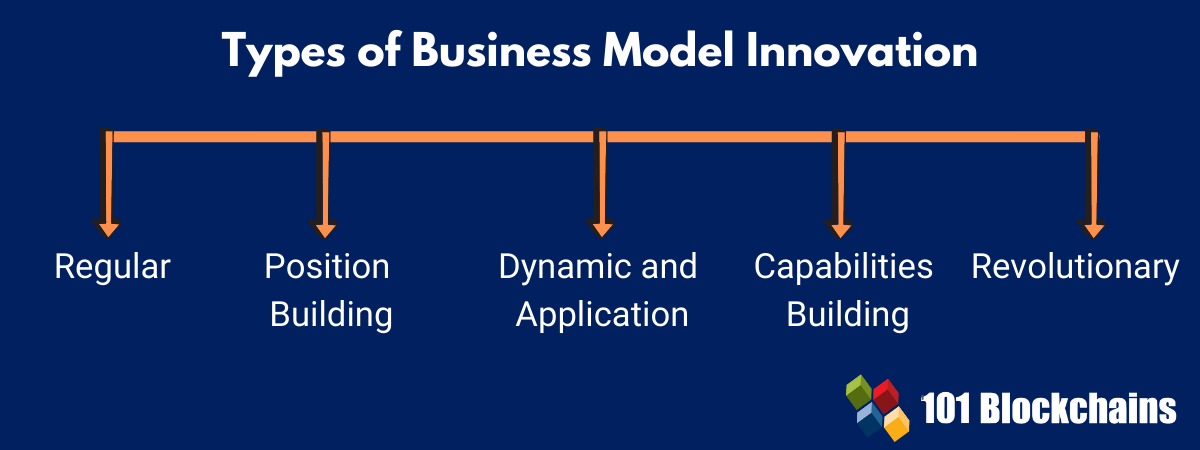Learn how blockchain truly works, master key definitions, and uncover what makes smart contracts so "smart." Dive into the fundamentals, gain valuable insights, and start your blockchain journey today!

- Guides
Diego Geroni
- on October 11, 2021
Business Model Innovation and Its Importance
The recent upsurge in demand for business model innovation has been dramatic and exceptionally beneficial for various reasons. Technology has been one of the foremost drivers of innovation in business models. In addition, the increasing levels of global competition among businesses have also spurred the demand for innovation to differentiate a business from another. Furthermore, a global pandemic has changed the way businesses operate, with many struggling to build or sustain their competitive advantage.
However, the businesses which have successfully navigated their way through the challenges of the pandemic have strong business models backing them up. This is where you would find the significance of business model innovation in entrepreneurship and business in general. The following discussion offers you an in-depth overview of the definition and importance of innovation in business models with examples.
Curious to learn how business model innovation can support the growth of your business? Join the Standard & Premium Plans and Enroll Now in Business Model Innovation Course!
Defining Business Model Innovation
The foremost mistake people make in understanding business models is the assumption of business models as just the pricing model for products and services of a business. Well, pricing is obviously one of the significant aspects of the business model. However, the business model is basically an approach of the organization for creating, delivering, and capturing value for its customers.
Therefore, successful business models focus on a holistic approach through the integration of different components of a business into well-organized systems. So, business model innovation can be defined as the new approach for organizing all the essential components of a business together in a well-organized and articulated system.
So, what is the best description of business model innovation? It is clearly evident that a business model is a strategy or a document that shows how an organization delivers value for its customers. It offers a detailed overview of the existing target market of the organization, its needs, and the ways in which the products or services of the business help in addressing the needs of the target market.
Innovation in business models basically refers to adjusting the business model in accordance with emerging trends. Generally, innovation in business models focuses on introducing fundamental changes in the way a company delivers value for its customers. Businesses could work on developing new distribution channels or new revenue streams as part of their plans for innovation in their business model.
Also Read: 4 Steps to Business Model Innovation
Characteristics of Business Model Innovation
The characteristics of business model innovation are also important elements you need to understand the significance of innovation in business models. Innovation in the business model focuses on introducing simultaneous and mutually supportive changes to the value proposition for customers.
The important characteristics of business model innovation dictate the changes at the value proposition level. You can understand the characteristics of innovation in business models by taking a look at the components. The important components for innovative business models refer to the selection of target segment, revenue model, and product or service offerings.
The characteristics of business models also draw attention towards the operating model level. Innovation in business models should also focus on the implications for the business itself. Therefore, you can find the important traits for driving profitability, value creation, and competitive advantage with business model innovation in entrepreneurship.
Confused to differentiate Mintable, Nifty Gateway, OpenSea, and Rarible? Check out this detailed comparison of Mintable vs Nifty Gateway vs OpenSea vs Rarible to clear all your doubts.
Importance of Business Model Innovation
The next important question pertaining to business model innovation theory points out its importance. You need to realize that a business that does not focus on its business model as an overall entity could compromise some of its initial strengths. For instance, some businesses could start to deviate from the actual needs of customers.
Some businesses look for optimization of product delivery while trading off the ability to create value. You could come across a wide variety of reasons for which such things happen. For example, the management could have a strong emphasis on the strategies and actions of competitors. On the other hand, pressure from shareholders for ensuring short-term profits could also be one of the notable causes for trading off the interests of customers.
So, it is clearly evident that many industries face the need for innovation in business models. They are experiencing troubles in aligning the true interest of customers and the service providers. The Healthcare sector is one of the prominent examples which can show the significance of different characteristics of this innovation. Private hospitals have a lot to gain when a patient keeps coming back regularly. On the other hand, the patient wants to stay healthy and never visit the doctor in the first place.
On the other side of the spectrum, you can look at flexible subscription services in business models as a vital indicator of the significance of innovation. Subscription services have to create value for the customers constantly so that the customer keeps the subscription. The longer the businesses hold on to customers, the more likely they are to earn higher profits. As a result, you can notice how innovation can empower strong alignment between shareholder and customer value.
Also Check: What Are Privacy-Enhancing Technologies (PETs)?
Example of Business Model Innovation
The next aspect in understanding innovation in business models would refer to its examples. Examples offer a practical overview of the ways in which brands are capable of transforming the way they operate. In addition, you can also decipher how brands are successful in offering improved value to their consumers with innovation. The most promising example of business model innovation is that of renowned automobile manufacturer Rolls-Royce.
Rolls-Royce is also a reputed aircraft turbine manufacturer known for its ‘power-by-the-hour business model. Prior to the innovation in its business model, Rolls-Royce operated exclusively as a product business. According to the previous business model, the engine would become a property of aircraft manufacturers for a large one-off sum. However, the new business model of the company does not focus on selling engines.
On the contrary, the new innovative business model of Rolls-Royce imposes hours on the airlines. How? Airlines have to pay only for the operating time of the engine without any obligation for purchasing the turbine engines. The engine would remain as a property of Rolls-Royce. The company also takes responsibility for engine maintenance and repairs. Such type of business model clearly resembles a performance-based contracting approach. As a result, Rolls-Royce was able to create advantages for its customers and the brand itself.
Types of Business Model Innovation

Business model innovation, in theory, sound quite appealing, especially considering the fact that it helps in adapting to new changes. However, it is also important to note that innovation is never single-dimensional. You can attempt innovation in business models from various perspectives. Here are some of the notable types of this innovation, which can help you understand the concept better.
Also Check: The Opportunities and Barriers of Business Model Innovation
-
Regular
In the case of regular approaches for innovation in business models, new firms use exiting capabilities. Such type of business model ensures that existing markets can retain their competitiveness. In addition, the products from the old firm or model could have substantial command over market share for maintaining competitiveness.
-
Position Building
Another addition among the types of business model innovation would also refer to the position-building business model. The approach focuses on products and services in the new model overpowering the products and services in the old business model. In this case, the old business model becomes non-competitive, albeit with the same capabilities of both business models.
-
Dynamic and Application
Classification of business model innovation also brings the dynamic and application approach for innovation. The different classifications for approaches in innovation for business models follow one common assumption classifying the business model as static. Dynamic and application approach in innovation negates this assumption. Business models could start as regular models and then shift to different variants according to the requirements.
-
Capabilities Building
The use of capabilities building innovation also reflects on another prominent approach in business model innovation. As the name implies, capabilities for the new business model are considerably different from those in the old business model. However, the old model also maintains competitiveness like the new one. In such cases, the capabilities for the new business model must be developed from scratch or obtained in any manner.
-
Revolutionary
Another prominent addition among the different types of business model innovation refers to the revolutionary approach. The core capabilities underpinning the new and old business models bear stark differences to one another. Interestingly, the new business model could not leverage the capabilities of the old business model. A revolutionary business model presents new definitions for creating and capturing value by reversing the previous approaches for performing value chain activities.
Learn non-stop with 101 Blockchains free blockchain resources and take your blockchain expertise to the next level.
Bottom Line
The role of business model innovation for transforming businesses for the modern landscape is undeniable. It helps businesses understand the areas they need to improve for delivering value to their customers. At the same time, innovation also focuses on enabling businesses to empower their profits and long-term growth. The notable examples of this innovation show how efficient it can be for modern businesses. With adaptability being the key requirement for businesses in today’s competitive landscape, it is difficult to ignore innovation in business models. At the same time, it is important to note that innovation of business model is not a cakewalk. You need to understand the basics of the ways in which businesses and industries change. Learn more about the stories of success and failures of innovation approaches followed by businesses in the past. Build your own innovative business model and soar towards success!






